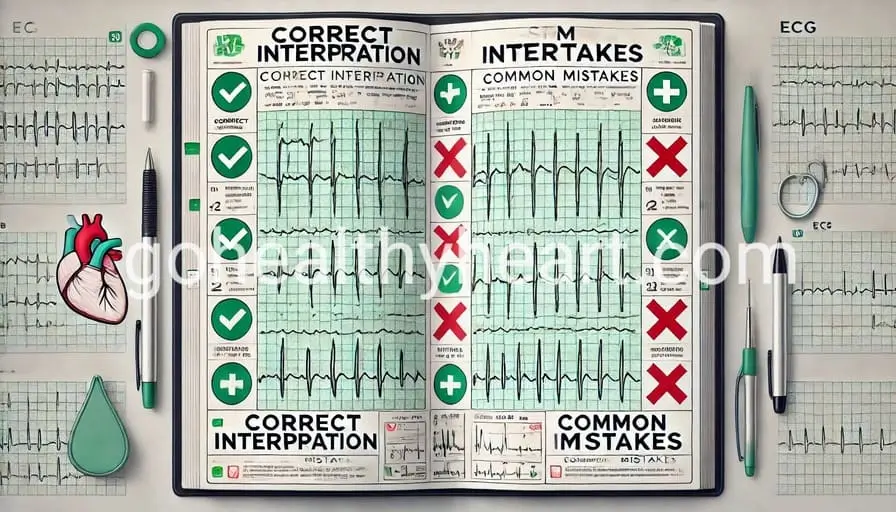Master ECG Interpretation Basics in 5 Simple Steps

Did you know that approximately 300 million ECGs are performed worldwide each year? Yet studies show that up to 33% of ECG interpretations contain errors that could impact patient care! Whether you’re a medical student, nurse, or practicing clinician, mastering ECG interpretation is a crucial skill that can literally save lives. I’ll break down the fundamentals of ECG interpretation basics into simple, digestible steps that will build your confidence and accuracy.
Fundamental Principles of ECG Interpretation
The foundation of accurate ECG interpretation lies in understanding its core components. Each wave and interval on an ECG represents specific electrical activities within the heart. Learning systematic ECG interpretation starts with mastering these basics.
The key elements for proper ECG interpretation include:
The P wave represents atrial depolarization and should be upright in lead II. A normal P wave duration is less than 0.12 seconds with an amplitude less than 2.5mm. When interpreting ECGs, this wave provides crucial information about atrial activity and helps identify abnormalities.
The QRS complex reflects ventricular depolarization and normally lasts 0.06-0.10 seconds. Successful ECG interpretation requires careful analysis of the complex’s three potential waves: the Q wave (first downward deflection), R wave (upward deflection), and S wave (final downward deflection).
The T wave represents ventricular repolarization and should be upright in most leads. Your ECG interpretation skills must include recognizing normal and abnormal T wave morphology, as these changes can indicate various cardiac conditions.
Systematic Methods for ECG Interpretation
When performing ECG interpretation, following a systematic approach is essential. Here’s a proven method that ensures thorough analysis:
- Rate Assessment: Begin your ECG interpretation by calculating the heart rate using either:
- The box method (300 divided by the number of large boxes between R waves)
- The six-second strip method (number of QRS complexes in 30 large boxes multiplied by 10)
- Rhythm Analysis: The next step in ECG interpretation involves determining rhythm regularity by examining R-R intervals. Look for consistent spacing between complexes.
- Axis Determination: Proper ECG interpretation requires calculating the electrical axis using leads I and aVF. A normal axis falls between -30° and +90°.
- Wave Measurement: Complete ECG interpretation must include systematic measurement of:
- PR interval (normal: 0.12-0.20 seconds)
- QRS duration (normal: 0.06-0.10 seconds)
- QT interval (should be less than half the preceding R-R interval)
Advanced ECG Interpretation of Normal Sinus Rhythm
Mastering ECG interpretation requires a solid understanding of normal sinus rhythm (NSR). To confirm NSR during your ECG interpretation, look for:
- A normal P wave preceding each QRS complex
- Regular R-R intervals
- Heart rate between 60-100 beats per minute
- Normal QRS morphology
Your ECG interpretation skills should account for age-related variations. Children typically have faster heart rates and shorter intervals, while elderly patients may show slight conduction delays even in normal settings.
Common Challenges in ECG Interpretation
When developing your ECG interpretation expertise, you’ll encounter several common abnormalities:
Arrhythmia Interpretation:
- Atrial fibrillation: Irregular rhythm with no discernible P waves
- Premature ventricular contractions: Early, wide QRS complexes
- Bradycardia and tachycardia: Rates below 60 or above 100 respectively
Advanced ECG Interpretation of Conduction Abnormalities:
- First-degree AV block: PR interval > 0.20 seconds
- Bundle branch blocks: QRS duration > 0.12 seconds
- Heart blocks: Progressive disruption of AV conduction
Clinical Documentation in ECG Interpretation
Proper documentation is crucial for clinical ECG interpretation. Your analysis should include:
- Patient identification and demographics
- Date and time of recording
- Technical quality of the tracing
- Rate and rhythm analysis
- Interval and axis measurements
- Comparison with previous ECG interpretations
- Clinical correlation with patient symptoms
Critical findings requiring immediate attention in ECG interpretation include:
- ST-elevation in contiguous leads
- New left bundle branch block
- High-grade AV blocks
- Ventricular tachycardia
Conclusion: Mastering ECG Interpretation Basics
The journey to mastering ECG interpretation basics combines theoretical knowledge with practical experience. By following this systematic approach to ECG interpretation and regularly practicing these principles, you’ll develop the confidence to accurately analyze ECGs in clinical settings. Remember, every ECG tells a story – your skill in ECG interpretation can make a crucial difference in patient care.
Ready to enhance your ECG interpretation skills? Start with Oxford Medical Education’s comprehensive ECG interpretation guide and gradually build your expertise through regular practice and continuous learning.



